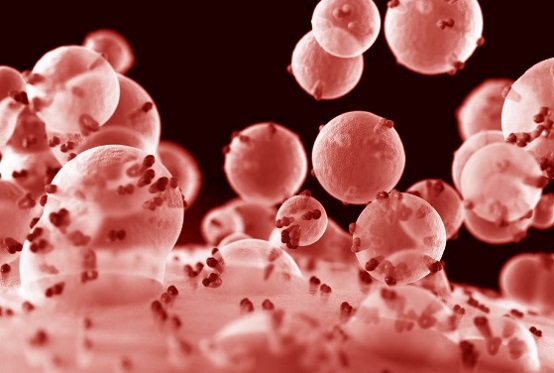Escherichia coli linked to alarming surge in vesicle production in COVID-19 patients with bacterial coinfections
Nikhil Prasad Fact checked by:Thailand Medical News Team Apr 17, 2025 2 days, 3 minutes ago
Medical News: In a significant scientific breakthrough, researchers from Mexico have discovered that a specific component from Escherichia coli (E. coli) bacteria can dramatically stimulate the production of cellular structures called extracellular vesicles (EVs) in immune cells known as macrophages. These EVs—tiny bubble-like particles that cells use to communicate—may be playing a much larger role in worsening COVID-19 infections, especially when bacterial coinfections are involved.
 Escherichia coli linked to alarming surge in vesicle production in COVID-19 patients with bacterial coinfections
Escherichia coli linked to alarming surge in vesicle production in COVID-19 patients with bacterial coinfections
This
Medical News report is based on research conducted by teams from the Center for Research and Advanced Studies (CINVESTAV), the Hospital Regional de Alta Especialidad de Ixtapaluca (IMSS-BIENESTAR), the Genomics, Proteomics and Metabolomics Core Facility LaNSE, and the Hospital General de México. Their findings have opened new doors for diagnosing and potentially even treating patients with COVID-19 complicated by bacterial coinfections—an often deadly scenario that has flown under the radar in most clinical settings.
Understanding Extracellular Vesicles and Their Viral Ties
Extracellular vesicles are nano to microscale particles secreted by cells that can carry a variety of biological cargo, including proteins, lipids, and even genetic material. While EVs normally help with cell-to-cell communication and immune responses, viruses such as SARS-CoV-2 have been found to hijack these vesicles to spread themselves stealthily throughout the body.
Macrophages—key immune defenders—produce EVs naturally. But when they were exposed in laboratory conditions to a particular membrane fraction of E. coli (called SDS-SBMF), they began secreting huge amounts of EVs in a surprisingly short amount of time—just 30 to 120 minutes. These vesicles were also far more varied in size and content than usual, showing “polydispersity,” a term used to describe a wide variety of vesicle shapes and sizes.
What’s in the E coli Fraction and Why It Matters
The SDS-SBMF used in this study is rich in outer membrane proteins from E. coli, including OmpF, OmpA, OmpC, OmpX, and lipoproteins like lpp and rcsF. These bacterial components are known to interact with immune cell receptors and may trigger inflammation or immune modulation.
Upon exposure to SDS-SBMF, macrophages released large EVs, some as big as 3 microns—many times larger than typical vesicles. The EVs contained key proteins like actin, GAPDH, apolipoproteins, and low-molecular-weight tyrosine phosphatase (LMW-PTP), which served as a marker to detect these vesicles under microscopes. Importantly, these EVs did not carry nuclear material, suggesting they weren’t the result of dying cells but were actively secreted in response to bacterial stimulation.
Direct Evidence from COVID-19 Patients
To vali
date their laboratory results, the researchers examined blood samples from 83 hospitalized COVID-19 patients. A staggering 98.8% of these patients were also suffering from bacterial coinfections, with common pathogens including Staphylococcus aureus, Streptococcus pneumoniae, Klebsiella pneumoniae, and Pseudomonas aeruginosa.
Using advanced techniques like NanoSight particle tracking and digital PCR, the researchers found that patients with COVID-19 and bacterial coinfections had significantly more EVs in their bloodstream compared to healthy individuals. These EVs also contained fragments of SARS-CoV-2 genes (specifically E and ORF genes), suggesting the virus was hitching a ride inside these vesicles—potentially allowing it to bypass immune defenses and spread more efficiently.
Implications for Diagnosis and Treatment
The explosion in EV production in coinfected COVID-19 patients suggests a double-edged sword. On one hand, EVs could be serving as vehicles for viral dissemination and immune modulation. On the other hand, they may offer a rich source of biomarkers for diagnosing severe cases or monitoring treatment responses.
The researchers suggest that measuring the levels and characteristics of EVs in blood could provide a powerful diagnostic tool—especially in identifying patients who have hidden bacterial coinfections exacerbating their COVID-19 illness.
They also propose that their in vitro model using E. coli bacterial fractions could be a scalable method to produce large quantities of macrophage-derived EVs for scientific and diagnostic research.
Why Coinfections Make COVID So Much Worse
It is well known that viral infections can weaken the body and make it more susceptible to bacteria. In the case of COVID-19, such coinfections significantly increase the risk of complications and death. In this study alone, 85.5% of the coinfected COVID-19 patients died—highlighting just how deadly this combination can be.
The researchers believe that the increased release of EVs may be part of this lethal synergy. When the body is overwhelmed with both SARS-CoV-2 and bacteria, the immune system’s macrophages go into overdrive, producing high volumes of EVs that might inadvertently assist the virus instead of stopping it.
Conclusion
This groundbreaking study has revealed a new layer of complexity in how bacterial coinfections might worsen COVID-19 outcomes. It shows that fractions of E. coli bacteria can provoke a dramatic increase in the release of extracellular vesicles from macrophages—vesicles that are not only more abundant but also capable of carrying viral genetic material. The presence of these vesicles in COVID-19 patients with bacterial coinfections offers a new avenue for diagnosis and potentially even therapeutic targeting. Monitoring these EVs could one day help clinicians detect hidden bacterial infections in COVID-19 patients earlier and more accurately, possibly improving treatment outcomes. However, more clinical research is needed before this model can be used in everyday healthcare settings.
The study findings were published in the peer reviewed International Journal of Molecular Sciences
https://www.mdpi.com/1422-0067/26/8/3741
For the latest COVID-19 News, keep on logging to Thailand
Medical News.
Read Also:
https://www.thailandmedical.news/news/rising-concern-over-hypervirulent-klebsiella-pneumoniae-strains-found-in-covid-19-patients
https://www.thailandmedical.news/news/greek-study-discovers-that-bacteria-from-the-gut-are-fueling-covid-19-severity
https://www.thailandmedical.news/news/stem-cell-therapy-promises-relief-for-covid-19-and-flu-co-infection
https://www.thailandmedical.news/articles/coronavirus
https://www.thailandmedical.news/pages/thailand_doctors_listings
https://www.thailandmedical.news/articles/hospital-news
